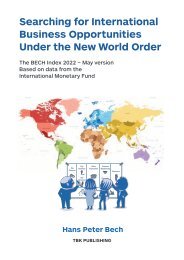And the winners are China and India - The BECH Index 2020
This whitepaper is based on the CIA national accounting estimates for 2019 and does not reflect the impact of the COVID-19 pandemic. The virus will no doubt claim a substantial portion of the expected economic growth in most countries, but it may not impact the overall distribution of industrial demand. We will not know for sure until we see the numbers in 2021. The Americas have experienced a 15 per cent decline in the period 2014-2020. The demand from Central and South America drops again in 2020, and the decline in demand from North America results in a net loss of 1.52 per cent for the area. The European Union has lost 11 per cent of global demand in the same period, and after a slight increase in 2018, the decline continues in 2020. Russia, the sixth most prominent market, has lost 13.79 per cent since 2014. The loss in 2020 is 2.18 per cent. North America and Europe continue to be very interesting areas with some of the biggest markets in the world. Because of increasing labour costs and public expenditure, there is a growing need for information analytics, and process and cost optimisation solutions. The Middle East’s share of global demand has decreased continuously since 2017, and the region has lost 3.65 per cent in four years. Future growth in the Middle East still requires a restructuring away from the dependency on oil and gas and general liberalisation of the economy. I remain sceptical that they will be successful with such a transformation and predict a continued decrease in the region. China continued its growth and has, with a 7.69 per cent growth from 2019 to 2020, become the most significant information technology market in the world pushing the USA to second place. For 2020 the Asia Pacific region’s share of global demand increased 2.33 per cent. The most prominent growth area is India showing a 34 per cent increase in the period 2014-2019. However, from 2019 to 2020, India’s share of world demand declined 1.57 per cent.
This whitepaper is based on the CIA national accounting estimates for 2019 and does not reflect the impact of the COVID-19 pandemic. The virus will no doubt claim a substantial portion of the expected economic growth in most countries, but it may not impact the overall distribution of industrial demand. We will not know for sure until we see the numbers in 2021.
The Americas have experienced a 15 per cent decline in the period 2014-2020.
The demand from Central and South America drops again in 2020, and the decline in demand from North America results in a net loss of 1.52 per cent for the area.
The European Union has lost 11 per cent of global demand in the same period, and after a slight increase in 2018, the decline continues in 2020. Russia, the sixth most prominent market, has lost 13.79 per cent since 2014. The loss in 2020 is 2.18 per cent.
North America and Europe continue to be very interesting areas with some of the biggest markets in the world. Because of increasing labour costs and public expenditure, there is a growing need for information analytics, and process and cost optimisation solutions.
The Middle East’s share of global demand has decreased continuously since 2017, and the region has lost 3.65 per cent in four years. Future growth in the Middle East still requires a restructuring away from the dependency on oil and gas and general liberalisation of the economy. I remain sceptical that they will be successful with such a transformation and predict a continued decrease in the region.
China continued its growth and has, with a 7.69 per cent growth from 2019 to 2020, become the most significant information technology market in the world pushing the USA to second place.
For 2020 the Asia Pacific region’s share of global demand increased 2.33 per cent. The most prominent growth area is India showing a 34 per cent increase in the period 2014-2019. However, from 2019 to 2020, India’s share of world demand declined 1.57 per cent.
You also want an ePaper? Increase the reach of your titles
YUMPU automatically turns print PDFs into web optimized ePapers that Google loves.
The BECH Index 2020
Table 6: The BECH Index for The Middle East 2014-20
Country 2014 2015 2016 2017 2018 2019 2020
Bahrain 0,05% 0,05% 0,05% 0,06% 0,06% 0,06% 0,05%
Egypt 0,81% 0,74% 0,79% 0,86% 0,88% 0,87% 0,86%
Iran 1,06% 1,03% 1,02% 1,13% 1,20% 1,20% 1,18%
Iraq 0,39% 0,36% 0,35% 0,46% 0,49% 0,46% 0,45%
Israel 0,27% 0,16% 0,17% 0,27% 0,26% 0,26% 0,25%
Jordan 0,08% 0,05% 0,05% 0,07% 0,07% 0,07% 0,07%
Kuwait 0,18% 0,28% 0,27% 0,22% 0,21% 0,20% 0,20%
Lebanon 0,08% 0,08% 0,07% 0,07% 0,07% 0,08% 0,08%
Oman 0,11% 0,11% 0,11% 0,14% 0,14% 0,14% 0,14%
Qatar 0,20% 0,24% 0,23% 0,26% 0,25% 0,25% 0,24%
Saudi Arabia 1,23% 1,40% 1,41% 1,41% 1,34% 1,31% 1,29%
Syria 0,06% 0,09% 0,04% 0,04% 0,04% 0,04% 0,04%
U.A.E. 0,47% 0,59% 0,61% 0,54% 0,51% 0,50% 0,50%
West Bank 0,02% 0,02% 0,02% 0,02% 0,02% 0,02% 0,02%
Yemen 0,11% 0,10% 0,07% 0,06% 0,05% 0,06% 0,06%
Middle East 5,12% 5,30% 5,27% 5,62% 5,58% 5,50% 5,42%
Table 7: The BECH Index for Africa 2014-20
Country 2014 2015 2016 2017 2018 2019 2020
Algeria 0,41% 0,41% 0,41% 0,46% 0,45% 0,43% 0,43%
Angola 0,09% 0,09% 0,09% 0,12% 0,12% 0,12% 0,11%
Benin 0,02% 0,02% 0,02% 0,02% 0,02% 0,02% 0,02%
Botswana 0,03% 0,03% 0,03% 0,03% 0,03% 0,03% 0,03%
Burkina Faso 0,02% 0,02% 0,02% 0,02% 0,02% 0,02% 0,02%
Burundi 0,01% 0,01% 0,01% 0,00% 0,00% 0,00% 0,00%
Cameroon 0,05% 0,05% 0,05% 0,06% 0,06% 0,06% 0,06%
Cape Verde 0,00% 0,00% 0,00% 0,00% 0,00% 0,00% 0,00%
Central African Republic 0,00% 0,00% 0,00% 0,00% 0,00% 0,00% 0,00%
Chad 0,02% 0,03% 0,03% 0,02% 0,01% 0,01% 0,01%
Congo, Republic of the 0,01% 0,02% 0,02% 0,02% 0,02% 0,02% 0,02%
Cote d'ivoire 0,07% 0,08% 0,08% 0,07% 0,07% 0,07% 0,07%
Dem. Rep of the Congo 0,04% 0,05% 0,05% 0,05% 0,05% 0,04% 0,04%
14
www.tbkconsult.com
→








